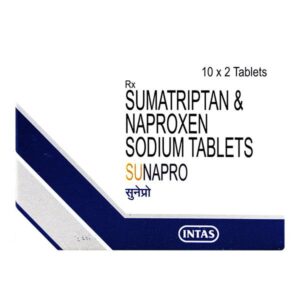NAPROXEN + SUMATRIPTAN
Naproxen: Naproxen is a nonsteroidal anti-inflammatory drug (NSAID) that is commonly used to relieve pain, inflammation, and stiffness caused by various conditions such as arthritis, menstrual pain, and musculoskeletal injuries.
The mechanism of action of naproxen involves inhibiting the production of specific chemicals called prostaglandins, which play a role in promoting pain, inflammation, and fever. By blocking the enzyme responsible for the production of prostaglandins, naproxen helps to reduce these symptoms.
The dosage of naproxen varies depending on the specific condition being treated. For mild to moderate pain and inflammation, the usual recommended dose for adults is 250mg to 500mg twice daily. However, the maximum daily dose should not exceed 1250mg. It is important to follow the instructions provided by your healthcare professional or the instructions on the medication label.
Like other NSAIDs, naproxen may cause some side effects. Common side effects include gastrointestinal issues such as stomach upset, heartburn, and nausea. These can be minimized by taking the medication with food or milk. Other potential side effects include headache, dizziness, drowsiness, and skin rash. In rare cases, naproxen may cause more severe side effects such as stomach ulcers, bleeding, and liver or kidney problems. It is important to seek medical attention if any serious side effects occur.
It is worth noting that naproxen should be used with caution in individuals with a history of gastrointestinal issues, heart problems, kidney disease, or bleeding disorders. It may also interact with other medications, so it is important to discuss any other medications or supplements you are taking with your healthcare provider before starting naproxen.
Overall, naproxen is a widely used NSAID that helps to relieve pain and inflammation. However, as with any medication, it is important to use it as directed and be aware of the possible side effects.
Sumatriptan: Sumatriptan is a medication used for the treatment of migraines and cluster headaches. It belongs to a class of drugs called selective serotonin receptor agonists.
The exact mechanism of action of sumatriptan is not fully understood, but it is believed to work by constricting blood vessels in the brain and reducing inflammation. This helps to relieve the pain and other symptoms associated with migraines and cluster headaches.
Sumatriptan is available in various formulations, including tablets, nasal sprays, and injections. The recommended dose for tablets is 25 to 100 mg, which can be repeated after a minimum of 2 hours if the initial dose doesn’t provide relief. The nasal spray is available in 5 to 20 mg doses, and the injection is typically given in a single dose of 6 mg.
Common side effects of sumatriptan include dizziness, flushing, tingling or numbness in the face or extremities, fatigue, drowsiness, and injection site reactions. It may also cause temporary increases in blood pressure, so caution should be exercised in individuals with a history of high blood pressure or cardiovascular disease.
It’s important to note that sumatriptan is not a preventive medication and should only be used to treat active migraine or cluster headache episodes. It should not be taken for tension-type headaches or used excessively, as doing so may lead to medication overuse headaches.
As always, it is crucial to consult with a healthcare professional for proper evaluation, diagnosis, and guidance on the use of sumatriptan or any medication.


